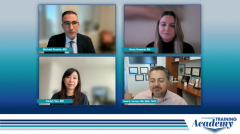
Managing Hypogammaglobulinemia Associated with Bispecifics in MM
A panel of experts on multiple myeloma discuss the use of IVIG in the management of hypogammaglobulinemia in patients treated with bispecific antibodies.
Episodes in this series

Transcript:
Saad Z. Usmani, MD, MBA, FACP: Another issue that was brought up in your case was the hypogammaglobulinemia in these patients. This is something that we’ve started to observe when anti-CD38 [monoclonal antibodies] started to be incorporated into the myeloma therapies, even in the frontline or early relapse setting. Dr Tan, what’s the general IVIG [intravenous immunoglobulin] prophylaxis guideline that you typically institute for your patients? Are you looking for a certain level, maybe under 500 or 400 [mg/dL], to start IVIG in these patients? Or do you wait for an infectious episode to happen along with that low IgG [immunoglobulin G] level?
Carlyn Tan, MD: That’s a great question, Saad. It’s been on my mind recently, especially with CD38 monoclonal antibodies being combined with bispecifics on clinical trials, and all these viral infections we’ve been seeing in these patients. Initially, I had been waiting for their IgG to be less than 400 to 500 [mg/dL] with recurrent infections. But now with the bispecific antibodies, it seems to make sense to be more proactive in terms of administering IVIG for prophylaxis, especially in the winter months, because their symptoms can get so bad so quickly and you end up having to hold treatment, just like with this patient. So recently, I have been more proactive in giving IVIG to these patients early in their course.
Saad Z. Usmani, MD, MBA, FACP: My rule of thumb had been if someone has not had any infectious episodes, then I’d wait for the first infection before starting IVIG. But I too have become more proactive. I think there are some International Myeloma Working Group guidelines that are going to be coming, and one of the things we were mulling over was the threshold. I think the threshold that is agreed upon is 400 [mg/dL]. I believe that’s something we also use in our other cellular therapy interventions. So again, I think we will be getting this consensus together around that.
This will be, unfortunately, not a cost-effective measure, because IVIG is not an infinite resource, and it’s not cheap either. So here again, going to alternate schedules of bispecifics will probably help, and even developing a fixed duration of treatment once patients have had a certain level of response. I think this is something we as a group are trying to do. Even with the commercial product, we are thinking about this. I think the use of IVIG and the infection patterns is something we’ll have to be very cognizant of and see the natural history of what happens to our patients here. This is another excellent case, excellent discussion. Thank you, Dr Scordo, for sharing this case with us.
Transcript edited for clarity.
Newsletter
Stay up to date on recent advances in the multidisciplinary approach to cancer.




















































































